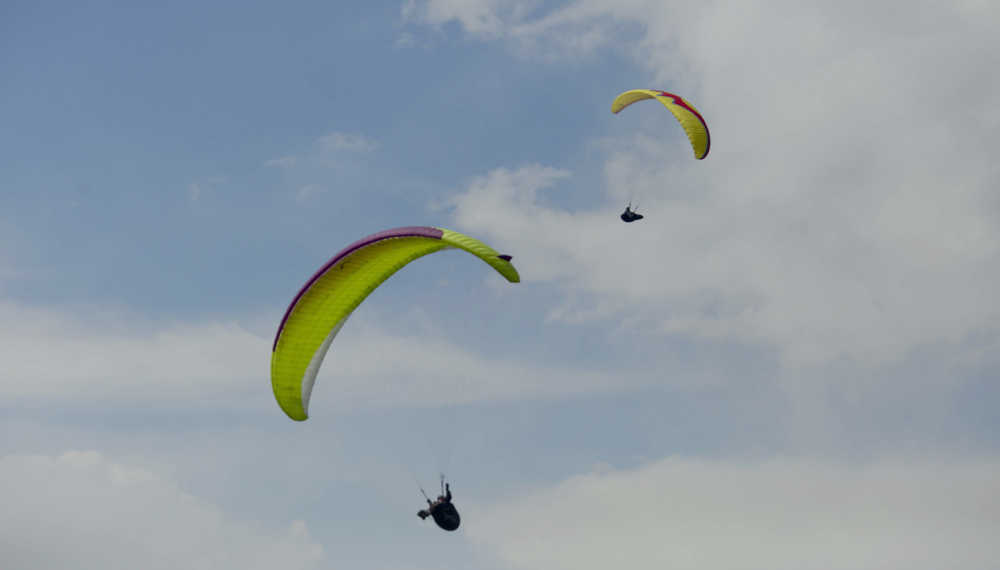PROVO, Utah (AP) — Ken Hudonjorgensen peers into the deep blue New Zealand sky; the year is 1989, and he sees someone flying up there above the hills.
While deeply perplexed at the sight of people hanging from large, sheet-like wings floating effortlessly in the air, Hudonjorgensen was thoroughly hooked.
“Once we found out what it was, I looked over to my wife and said ‘I have to go do that.’ And so we did,” said Ken Hudonjorgensen, the founder and director of Two-Can Fly Paragliding, a paragliding school based in Sandy.
“Ever since ‘89, I haven’t been able to stop,” Hudonjorgensen said. “I’m addicted.”
Hudonjorgensen and his wife had been in New Zealand teaching quality of life classes, but decided to take a break in 1989, reported the Daily Herald.
“We decided to take a break on teaching and decided to just not do work for a while. We decided on two years. Those two years never ended. Here we are.”
Hudonjorgensen immediately began to paraglide seriously and on a regular basis, until the normal trajectory of a hobby turned into a career and a passion. After thousands of flight hours, navigation, prep hours and training, Hudonjorgensen opened his own business.
“I was sitting there with a buddy one day and he just says to me ‘you do this all the time, why don’t you make a business of it?’ and the rest is sort of history, I think,” Hudonjorgensen said.
Paragliding, however, is a lot harder than it looks. “While it may be the most simple aircraft we have, it is also the most difficult to master,” Hudonjorgensen says.
Due to the lack of an engine, as well as a lack of landing gear, paragliding is a sport that takes finesse, balance and a keen sense of timing. Once one has the paragliding wing spread out, it’s the pilot’s job to wait for the perfect moment where enough wind has filled the sail-like wing, and to turn it around, face downhill, and begin to descend into a take-off. From there, one hopes the wind has enough strength to carry you into the air, taking flight.
According to some of his friends, Hudonjorgensen has pioneered or has helped pioneer 98 percent of the flight routes in northern Utah. Pioneering is the act of driving (or in most cases, hiking on foot) to find a take-off spot, and then by trial and error, make dozens of flights from that spot until one finds a suitable landing spot and a proper flight pattern that takes advantage of optimal wind conditions as well as thermal activity in the atmosphere.
The act of pioneering takes a lot patience, endurance and creativity.
“When you’re up in the air like that, you get lots of surprises,” said Jeff Silk, a friend of Hudonjorgensen and a long-time paraglider. “You have to be ready for anything, really. The wind can change in a flash.”
Hudonjorgensen offers one-time lessons as well as tandem lessons, for those who are beginners. In his classes, he offers rates at $110 per lesson (this is the introductory lesson, and will teach you the mechanics and technique of flying solo). He also offers tandem flights, in which he directs the flight under his expertise and the person flying with him can just sit back and relax. These flights will run you about $125, according to his website.
As a fully certified paraglider, he also has the rare ability to train people towards their certification in paragliding, which will run someone about $1,850. The cost covers about 30 lessons at three hours per lesson, sometimes longer if the weather is right.
While Hudonjorgensen is excited about teaching those who are interested in learning the art of paragliding, he is much more interested in spreading the love and passion of the sport that he has to those in his community.
“There’s just this magical feeling you get when your feet lift off the ground and you’re in free flight. I mean we say we are three-dimensional creatures, and that’s true; but we live on this plane, 24/7. And when your feet lift off the ground. There’s nothing like it.”
Just like any other sport, once you do it enough, you get picky. Hudonjorgensen and his friends say that after thousands of flights, sometimes the biggest thrill comes only after one has ascended thousands of feet into the air, where temperatures are freezing, and the buzz of the world can’t be heard.
“Sometimes I’ll only be up there for a bit, if the winds aren’t optimal. I don’t always have the best flights. However, even after some 40,000 flights, I always get that rush of having my feet leave the ground. There’s nothing quite like it.”

